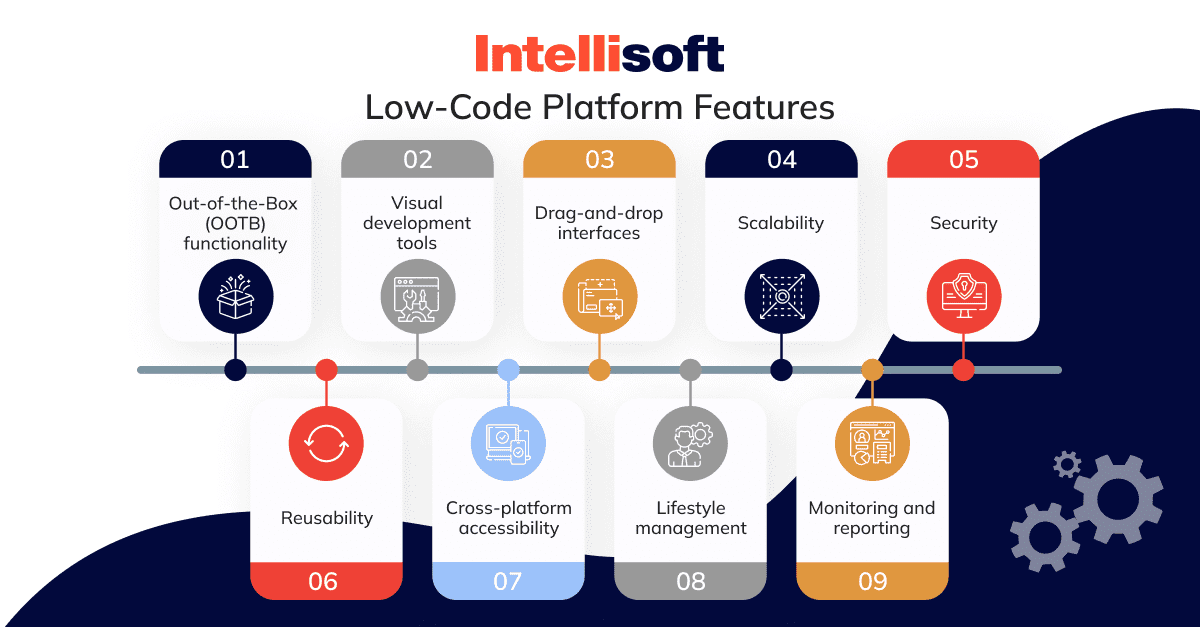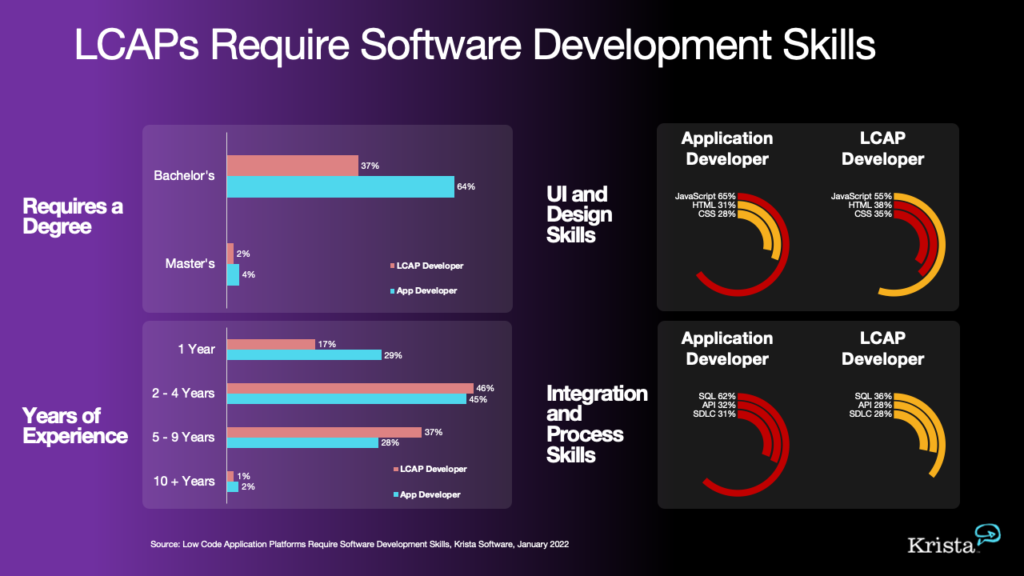Handy Tips To Selecting application development with Low-code platforms
Handy Tips To Selecting application development with Low-code platforms
Blog Article
The Advantages Of Low-Code Development For Speed
Low-code application development significantly enhances development speed due to several key factors: Visual Development Environment:
Drag-and-Drop Interfaces: Low-code platforms provide visual tools for designing applications. Drag-and-drop elements enable developers to rapidly build applications without the need to write lengthy code.
Pre-built Templates and Components: A lot of low-code platforms have pre-built templates and components, which enable developers to swiftly create and prototype applications without the need to begin from starting from scratch.
Reduction of Coding Requirements
Automated Code Generating: The low-code platform automatically generates the code underneath based upon the visual models that developers design. This reduces the need to code manually and improves the speed of development.
Reusable Parts: Developers will have the ability to reuse parts that are reusable across their projects, thereby reducing the time required for writing and testing of code.
Streamlined collaboration:
Integrated Development Tools : Low codes platforms usually have tools for testing versions, deployment and version control. They facilitate collaboration among teams.
Citizen Development - Business users, non-developers and other stakeholders are able to contribute to application creation by using user-friendly interfaces. This reduces the bottleneck caused by absence of professional developers.
Rapid Iteration & Prototyping
Rapid prototyping: Developers can create quickly prototypes to collect feedback and confirm ideas, which results in quicker cycles of iteration.
Easy Modifications – The visual nature of low-code applications allows easy updates and changes, which speeds the refinement of applications based upon user feedback.
Pre-built Integrations:
API Integrations. Low-code platform often include pre-built connectors and APIs for services that are popular that reduce the time needed to integrate with other systems.
Data integration: Tools for data integration are included to help simplify the process.
Deployment Scaling
One-Click Deployment: A lot of low-code platforms offer the option of deploying with one click, drastically reducing the amount of time and effort required to deploy apps.
Cloud-based Solutions: Cloud platforms with low-code enable developers to focus on the design and function of their applications rather than worrying about logistics for deployment.
In general, low-code development has the advantage of speed due to its capacity to automate and simplify many aspects of development. This allows faster app delivery and a simpler adaptation to changing needs. Take a look at the most popular from this source on Low-code Platform for application development for website recommendations including rapid action development, microsoft azure sql, app modernization, microsoft azure sql, low code development platforms, rapid application design, application development platforms, push notifications android, low code platforms, develop mobile application and more.
Low-Code Software Is Cost-Effective.
The low-code approach to application development is a cost-effective option that has many benefits. It's an excellent choice for businesses looking to increase their budgets while delivering top-quality applications. Here are the top benefits: Reduced Development Costs:
Lower Coding Requirements Low-code platforms reduce the requirement for extensive hand-coding. This reduces the time and effort that developers must to spend on building applications. The result is lower labor costs.
Fewer Developers: Because low code development is speedier and easier to develop, there are less specialized developer resources required. Costs for hiring and staffing can be drastically reduced.
Faster Time to Market
Accelerated Development: Low-code platforms offer visually-based development tools, components that are pre-built and other features that enable rapid development of software. Businesses can bring their products on the market much faster. This may result in quicker revenue generation and better position in the marketplace.
Rapid Prototyping. Through the rapid creation and testing prototypes, companies can speed up development and iterate faster based upon user feedback.
Lower Maintenance Costs
Because of their modular architecture and standardised components, low-code platforms usually make it easier to maintain applications. Maintenance and support cost is reduced.
Automated updates: A lot of low code platforms automatically handle patches and updates, ensuring that applications are secure and up-to-date with no need for extensive manual intervention.
Efficient Resource Utilization:
Low-code platforms allow businesses and other non-developers to take part in the process of development. This makes it possible for enterprises to profit from the talents of a diverse range of employees.
IT departments can focus on Strategic Initiatives: Instead of being bogged down by routine work, IT departments are able to focus their energies on strategic initiatives that increase the efficiency and productivity of their departments.
Price models that can be scaled:
Subscription Pricing: Many platforms with low-code offer flexible pricing models that are based on subscriptions that can be scaled in accordance with the amount of usage. This allows businesses the ability to adjust their spending in line with their growth and needs, without having to pay large upfront costs.
Pay-Assosiated Alternatives: Some platforms provide pay-assosiated choices. These ensure that businesses pay only for the resources used, which is beneficial to small and new businesses with limited funds.
Reduction in Third-Party Software Fees:
Low-code platforms usually come with functions that are integrated, eliminating the requirement to purchase additional tools or software. This could save you money on subscriptions and licensing costs.
Pre-Built integrations: These systems and services can be integrated with other popular services, which eliminates the requirement for custom-designed software and saves both time and money.
Increased ROI:
A faster return on investment (ROI) Through combining rapid application development with lower costs and a shorter time to market, companies can get a faster ROI for their apps.
Improved Agility - Businesses can quickly adapt to changes in the market and changing customer needs. This allows them stay relevant and to take advantage of opportunities that arise.
Costs of training are lower:
User-Friendly interfaces: Low-code platforms provide user-friendly and easy interfaces that cut down on the learning curve. They also reduce the need for lengthy courses of instruction.
Accessible Resources that are accessible. A lot of low-code platforms offer complete training materials, tutorials, as well community support. They make it less necessary for formal education, which can be expensive.
Collaboration can be made more efficient.
Enhanced collaboration tools: The integration of collaboration tools allows for better communication between team members and an improvement in overhead for projects.
Unified Development Environment. A single unifying software development environment could streamline processes and cut down on the cost and complexity of managing different software and platforms.
In the end, the value of developing low-code applications stems from its ability to cut maintenance and development costs as well as speed up time to market, optimize utilization of resources, as well as provide flexibility in pricing. All of these factors provide substantial financial benefits to businesses, making low-code a compelling choice for organizations aiming to increase their budgets for development and create high-quality, flexible and top-quality applications. Follow the most popular Legacy application modernization with Low-code for website examples including push notifications android, app dev platform, rapid app development, rapid application design, application modernisation, application modernization, build a docker container, cross platform mobile development, push notifications android, cross platform app dev and more.
Benefits Of Low-Code Application Development In Terms Of Customization And The Limitations
Low-code development provides an approach that is balanced to address limitations, while also allowing for customization. Here are the benefits:
Overcoming Complexity Barriers:
Simplified Development : Low-code platform reduces the complexity of development by providing components and templates that are pre-built. This allows for faster creation and deployment.
Guided Workflows - A lot of platforms have guided workflows or wizards that help developers navigate difficult procedures. This reduces the risk of making mistakes and guarantees accuracy.
Scalability Solutions:
Scalability built-in Lowcode platforms usually have features that enable scalable architecture. They enable applications to cope with increasing demands without major changes.
Performance Monitoring: Integrated performance monitoring tools and optimization tools ensure that applications are as efficient as they can be, regardless of their size.
Security and compliance:
Security features integrated into low-code platforms offer security measures like encryption as well as role-based access control, and automated compliance checking that address the most common security issues.
Regular updates: Platforms often change their security protocols as well as compliance measures, ensuring that their applications are secure against new threats.
Customization Options:
Extensibility:
Custom Code Integration: Low-code platforms typically permit the integration of custom codes (e.g., JavaScript, Python) that allows developers to extend the functionality beyond the standard offerings.
Custom Modules and Plugins: Developers have the option of creating custom modules or plugins in order to modify specific functionality to meet the specific requirements of a particular business.
APIs & Integration:
API Support: Full API support is provided to allow seamless integration and connectivity with other systems.
Third-Party Platforms Lowcode platforms are usually pre-built with connectors for third-party apps, making it simpler to integrate them and personalize the application.
Designing UI/UX that is flexible:
Flexible User Interfaces for Developers: Designers are able to modify and design user interfaces to meet specific design and usability specifications and provide a customized user experience.
Responsive Design: The apps can be tailored to fit different screen sizes and devices.
Business Logic Customization
Visual Workflow Builders: Visual tools used to create and modify workflows, business logic and processes enable developers to create complex and tailored processes without extensive programming.
Conditional Logic and Scripting: Platforms enable the integration of conditional logic and customized scripting to deal with specific business rules and scenarios.
Data Management
Custom Data Models Developers can create customized data models that are specifically tailored to the specific needs of a business. This ensures data handling is customized to every specific application.
Advanced Data Processing: The integration of advanced tools and capabilities for data processing allows customizations in the way data is analyzed in an application.
Balanced limitations through customisation
Frameworks and Standards
Low-code platforms comply with the industry standard and best practices. This helps maintain the highest quality and security of applications.
Governance Frameworks Governance Frameworks: Integrated governance frameworks ensure that any modifications don't compromise the integrity, compliance, or security of the application.
Iterative design and feedback:
Rapid Prototyping: Developers can quickly test and prototype customizations in response to feedback from users, enhancing the application according to their requirements.
Continuous Improvement: Platforms that use low-code enable continuous improvement which allow for customization and improvement as the business requirements change.
Empowering Users
Helping Citizen developers become empowered: The Low-Code platform's intuitive interfaces let non-developers modify the application. This increases the number of people who can contribute to improve and customize applications.
Training and Support: Many platforms offer comprehensive training and support to assist users with efficient modifications without compromising the application's stability or performance.
Overall, Low-code application creation gives you a framework that's sturdy and flexible enough to accommodate restrictions while allowing the possibility of extensive customisation. This allows companies to develop and maintain functional applications designed to meet their requirements while maintaining high standards for quality, security and scalability.